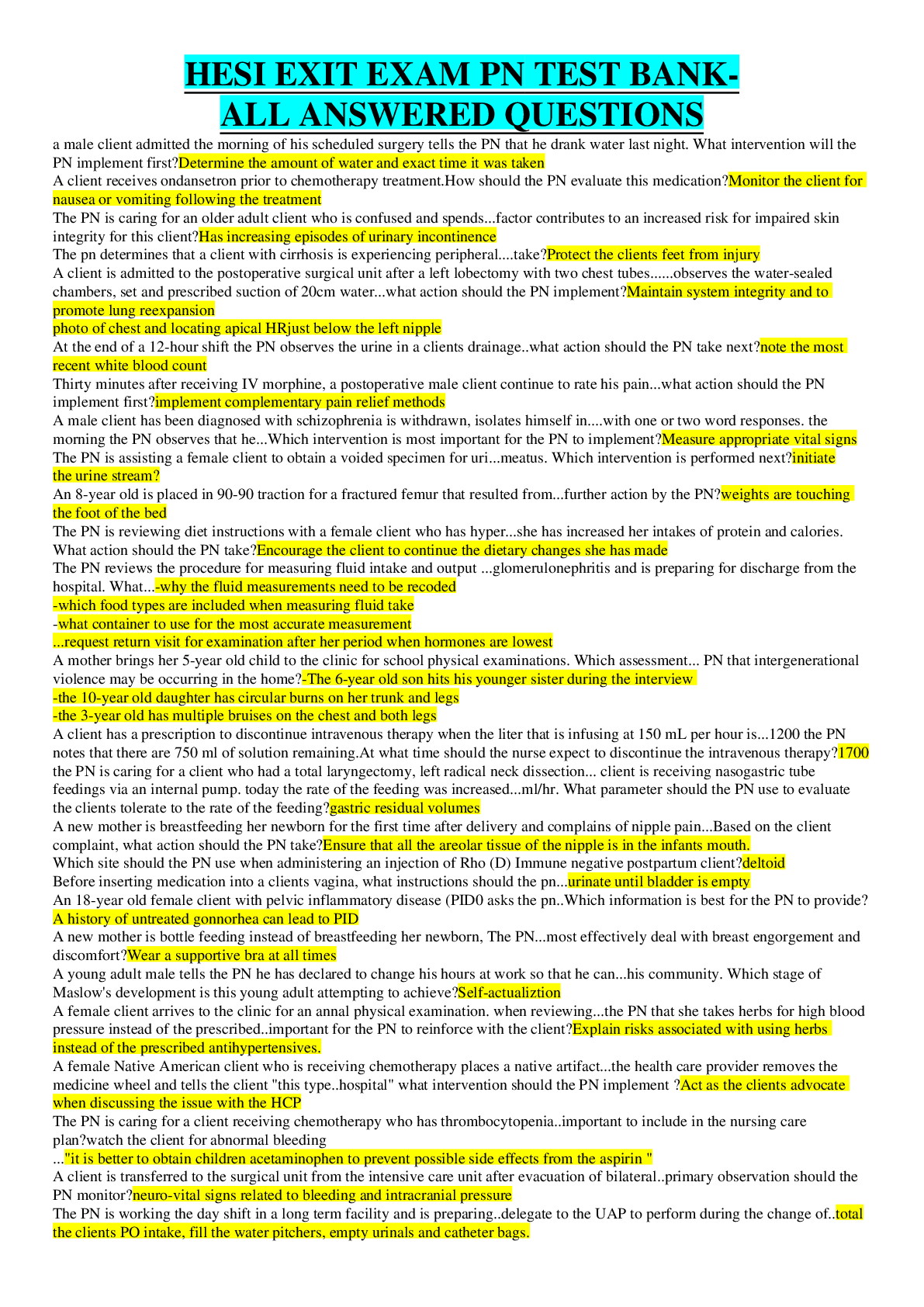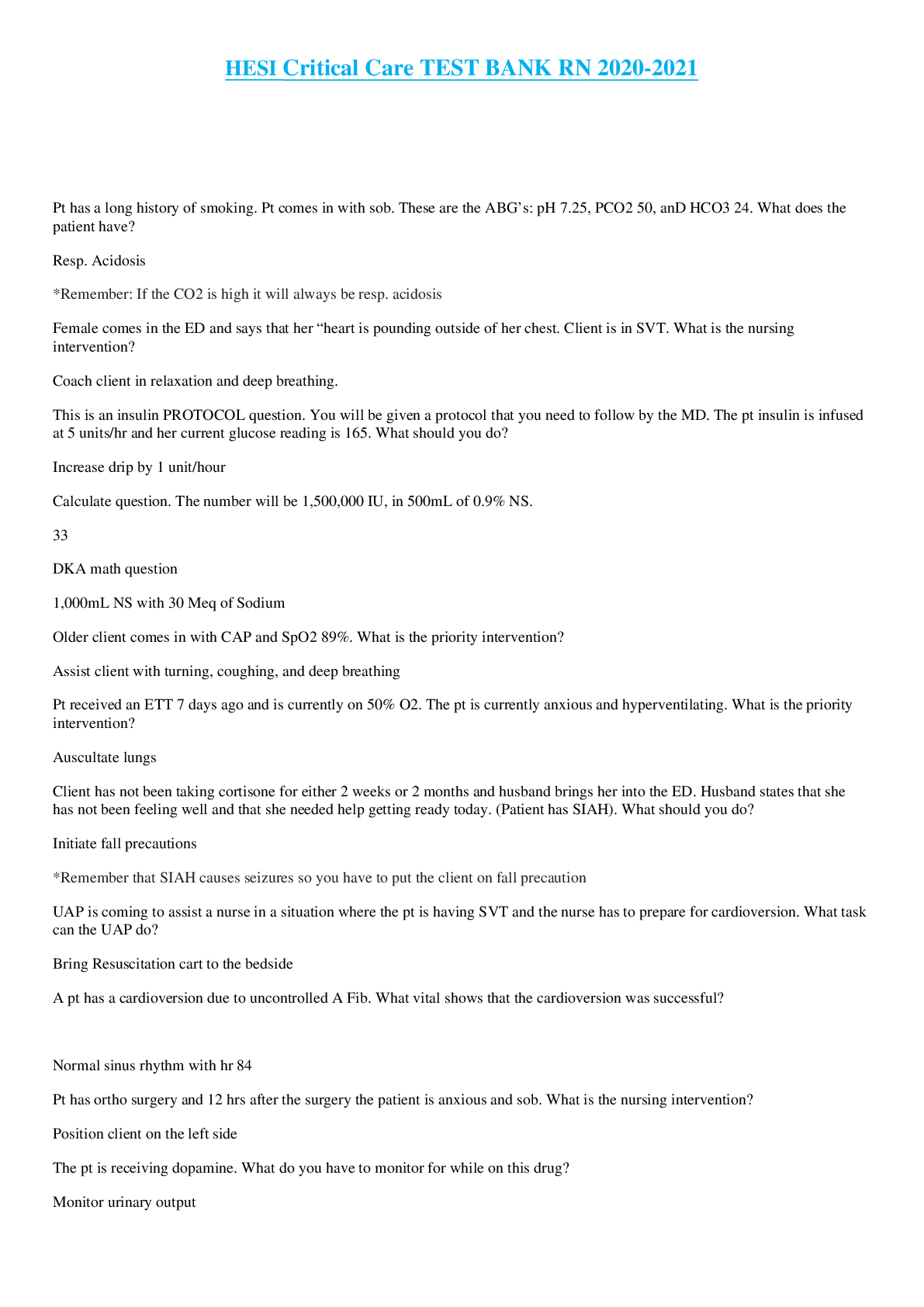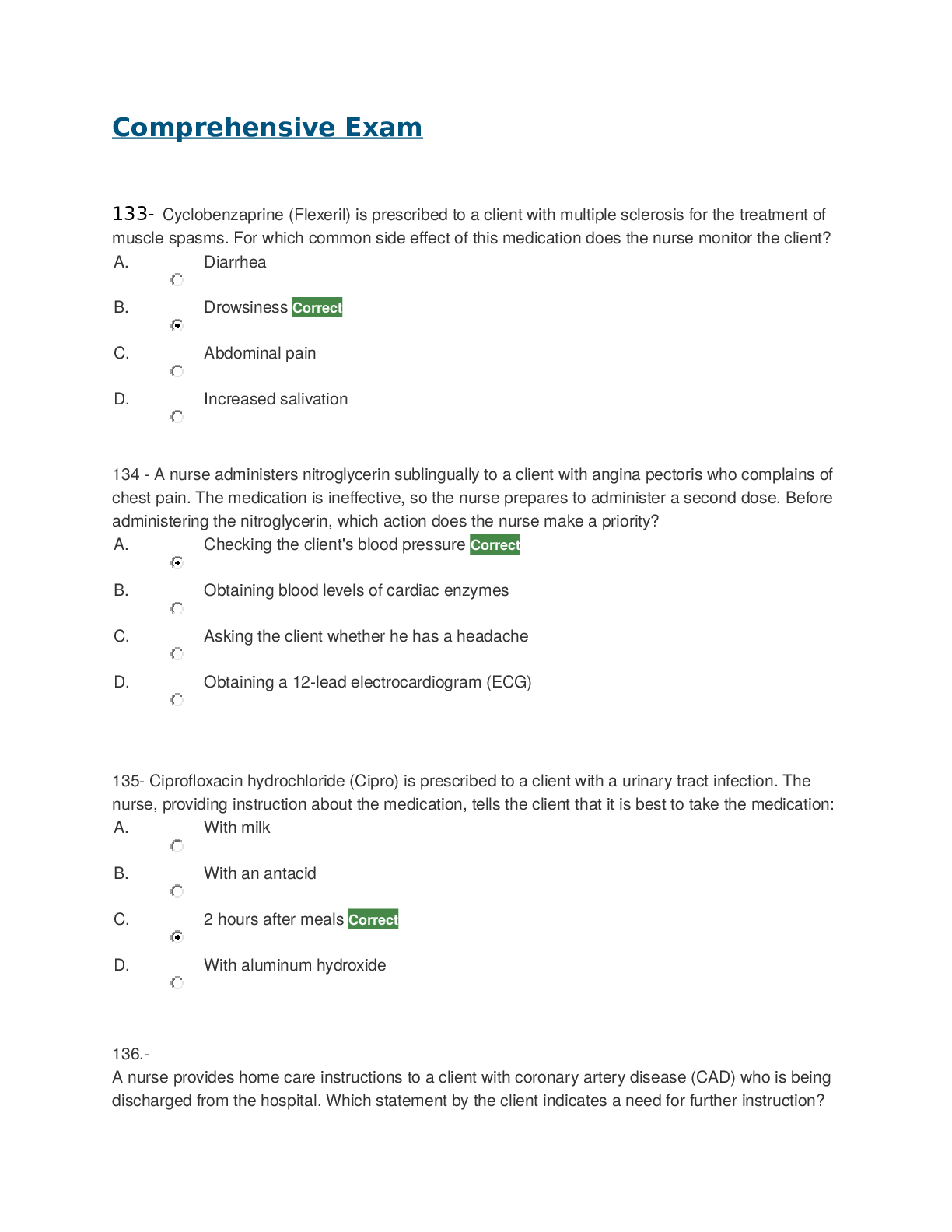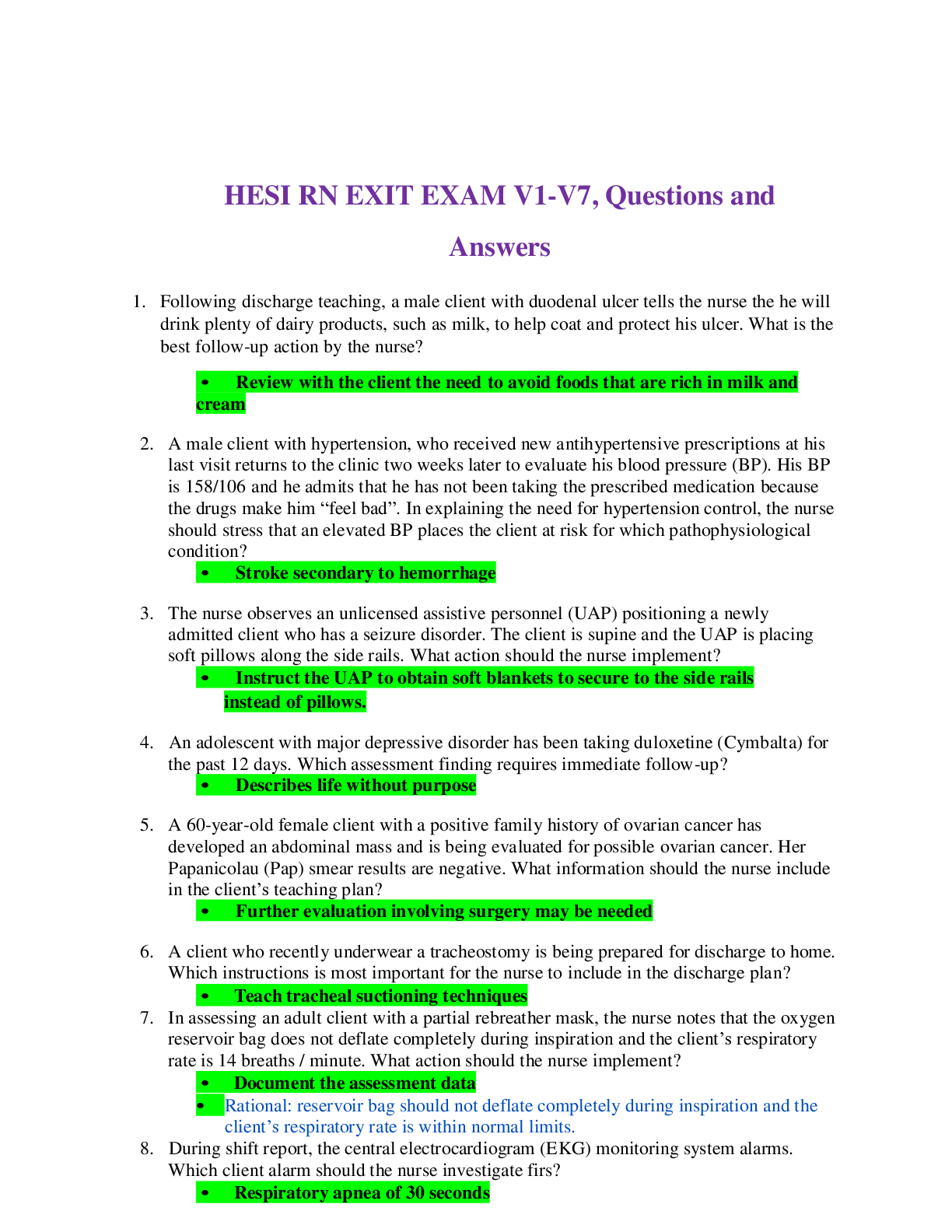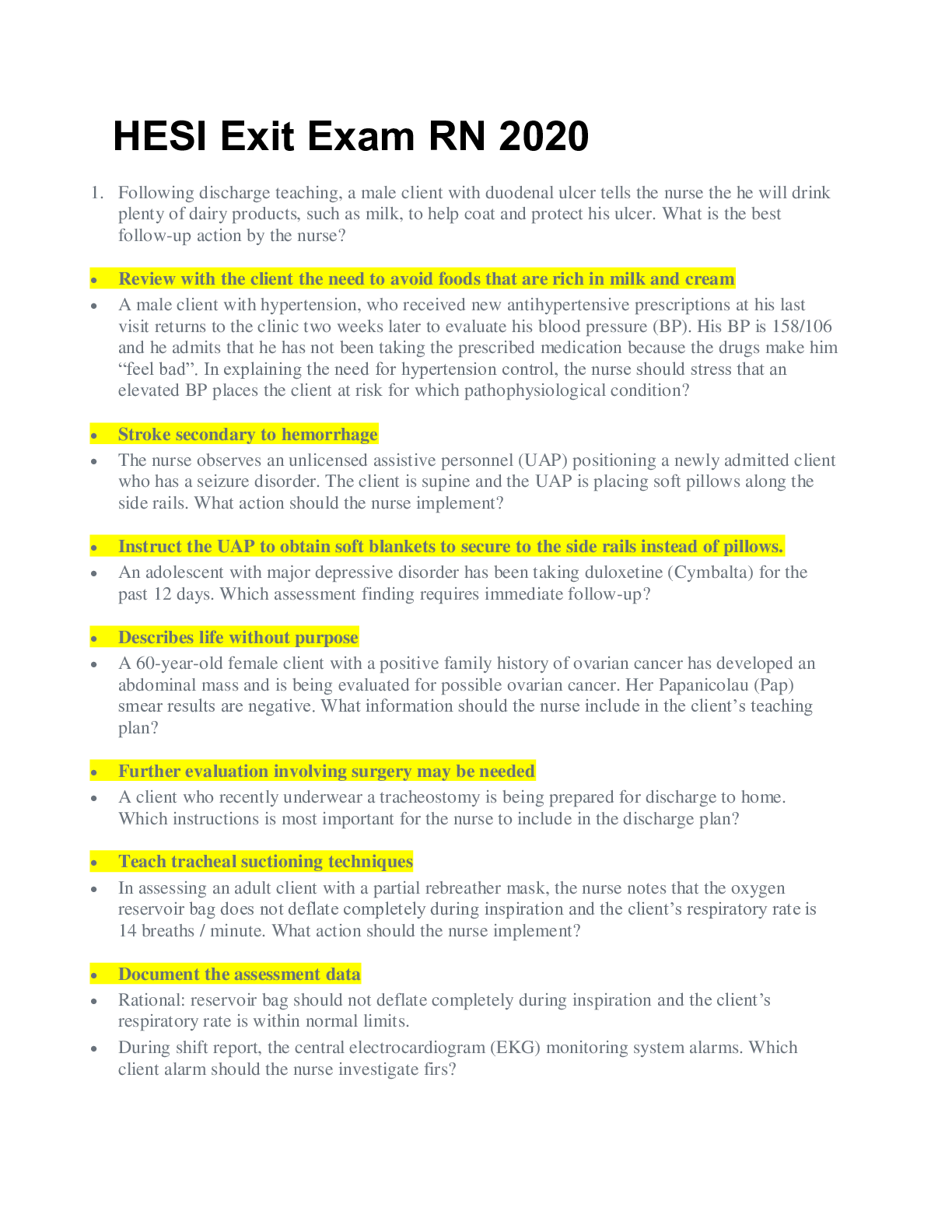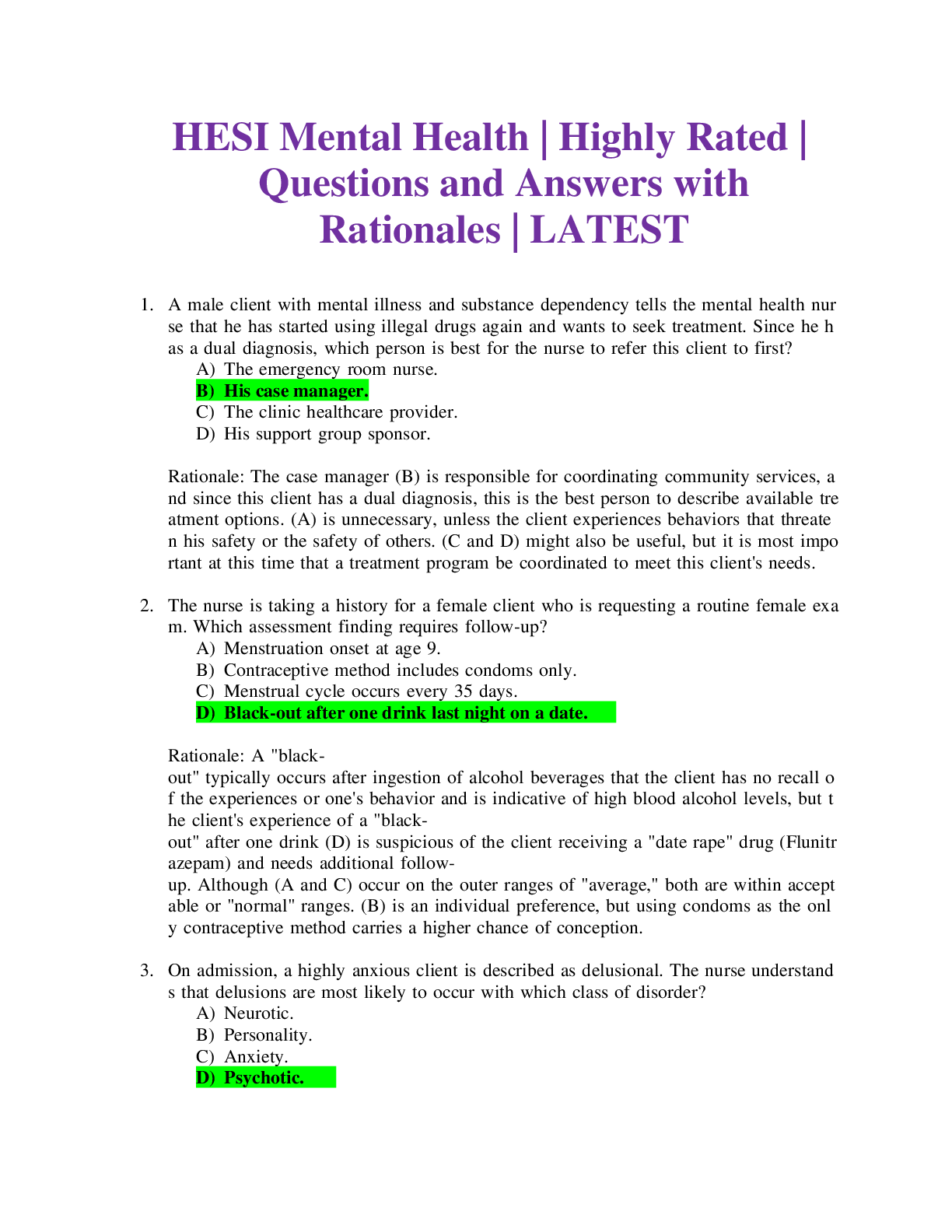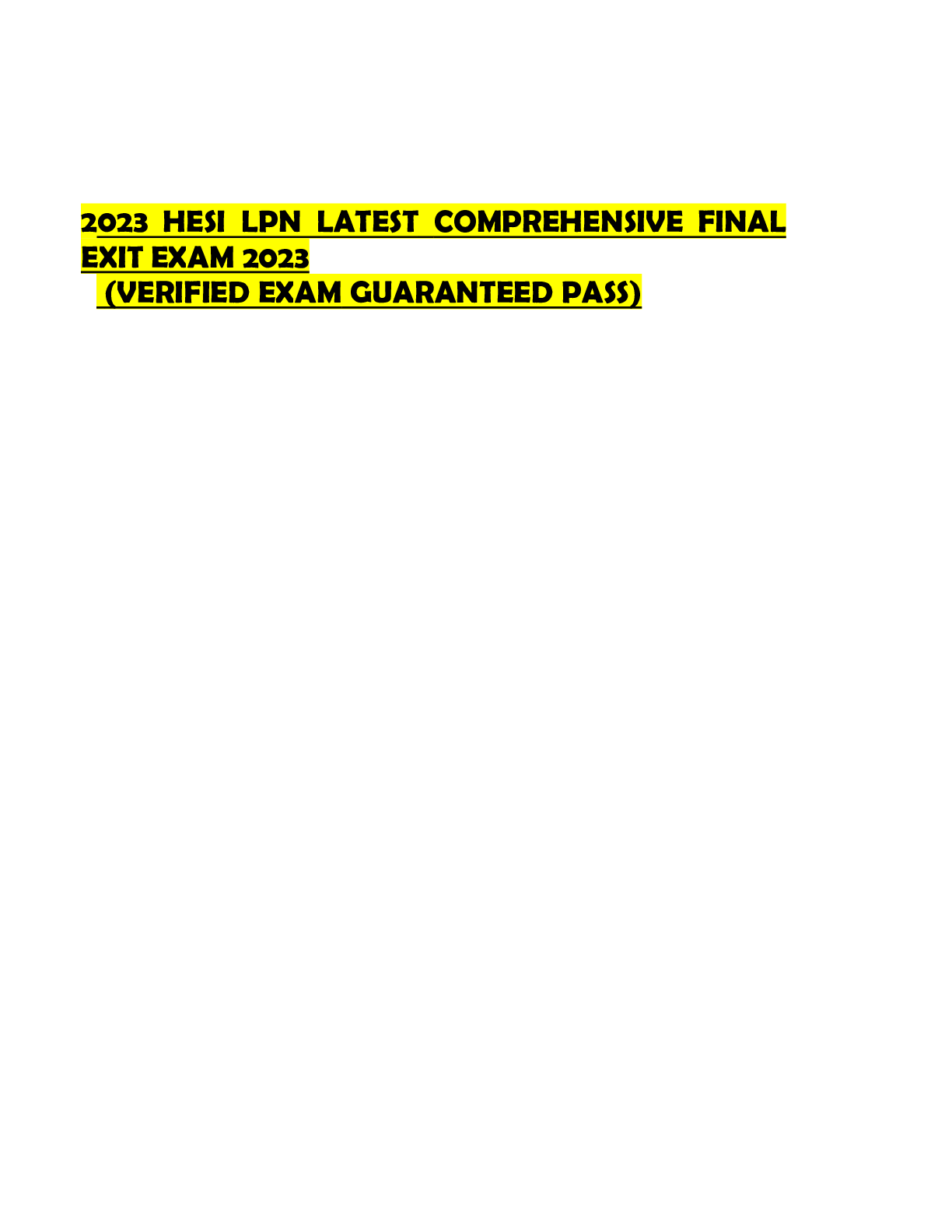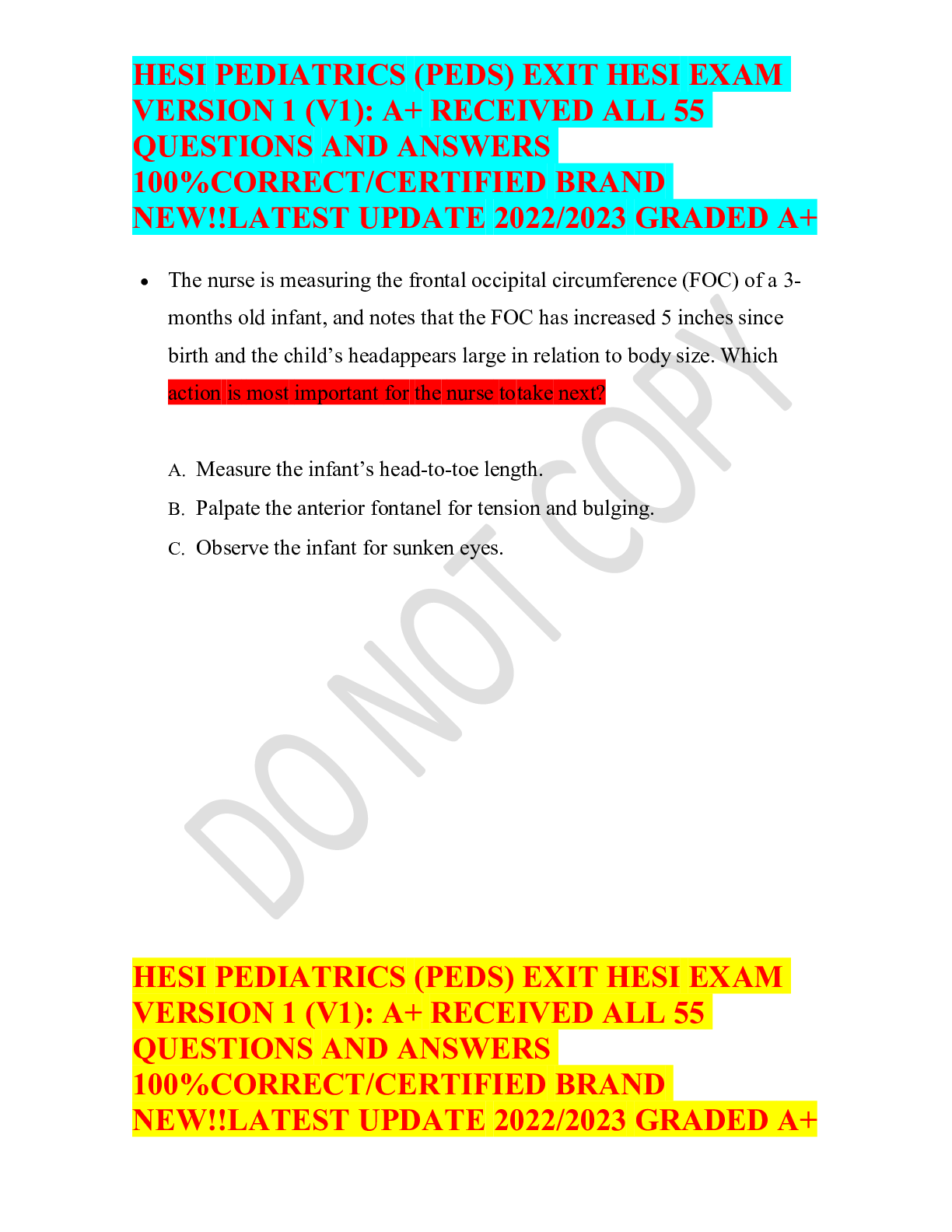OB HESI Study Guide
Document Content and Description Below
OB HESI Highlighted = on my HESI 2016 version (it depends on which version you may have which questions you will see below) 1. Good source of folic acid – peanuts 2. Mom getting hypotensive on sp... ine board after car wreck – roll her on her side on spine board 3. Mom goes to bathroom with contractions 5 min apart, you hear baby cry – hit call light for help 4. Iron (SATA) – dark stool normal, give at bedtime 5. Man calls clinic says his wife has been sad, happy, moody – tell him normal hormonal changes 6. Mag question – stop infusion due to mag tox 7. One question her contractions get really close and she is dilated, stop Pitocin, then contractions get 5 min apart – restart Pitocin per agency policy 8. Bright red trickling blood – lacerated cervix 9. Teach adolescent pregnant girls – proper nutritional needs 10. 42 wk ballard score – check blood sugar 11. Breast feeding woman asks about birth control – breast feed only every 2-3 hrs 12. Rubella vaccine – use birth control for 28 days 13. Baby as white curd patches in his mouth – discuss medicine with mother (candidiasis infection) 14. Mom has baby – she reaches out and traces profile with fingertips 15. HIV positive mom gives birth and is worried about passing it to baby – explain to mom AZT for baby after birth 16. Baby has to have COOMBS test, mom doesn’t want rhogam but will keep her from building up antibodies for future babies 17. HSV 2, baby born, vaginal delivery – isolate in nursery 18. Hormone for positive pregnancy test – human chorionic gonadotropin (HCG) 19. Swollen vagina is normal in female infant 20. Moro reflex is normal in infant 21. 800 ml output in an hour with mag question – just continue whatever you are doing 22. Woman has baby in a cab – start pitocin, massage fundus 23. Woman comes in with pain in her stomach – you start an IV, not type and cross blood 24. Put eye ointment in conjunctival sac of newborn (erythromycin) as prophylactic eye ointment for prevention of eye infections contracted from bacteria in birth canal 25. Had kid now complains of vaginal pain fullness – check vaginal/perineal area 26. Swollen vagina question is long and talks about salt wasting – normal finding explain about androgens 27. -1 placement of baby active labor 3 cm dilated, has to go to bathroom – check the patient’s cervix 28. Baby born to diabetic mother – check baby’s blood sugar 29. PKU baby – 25% any babies will have it too 30. Baby with clavicle problem – will have intracurvature 31. One question about a woman who drinks and has cut down – give her an “atta boy” and encourage her to reduce the amount even more 32. Woman getting radiation iodine – hold off on test to confirm if pregnant or not 33. Some type of fertility drugs – you need to report sudden increase in abdominal girth 34. Breast feeding baby and sore nipples – start feeding on the unaffected breast 35. Breast feeding mother has a diaphragm – use condom and foam until diaphragm can be refitted 36. Baby born to mother who has a positive drug screen for something – monitor baby for seizures 37. Baby has an apgar score of 3 – continue resuscitation 38. Baby is jaundice and brought back to hospital after 7 to 10 days – provide eye protection and placed under light or phototherapy 39. Pregnant woman with low Hct Hgb levels – this is normal because of increase in plasma levels 40. Woman in labor lying in supine position states she is finally comfortable – place a wedge under her right hip 41. Preparing a woman for triple screen or something test – you need to prepare to draw blood lab work42. Woman comes in stating her water broke – test with nitrate paper and if it turns blue then prepare to admit 43. Woman is having an amniocentesis test – nurse should check for signs of labor once it is complete 44. A newborn weighs 7.5 lbs at birth and weighs 7 lbs 24 hrs later – this is normal weight loss 45. Something about woman 12 weeks prenatal visit. What is important to discuss at this time? It is a cultural question answer is something about – birthing plans or techniques 46. Baby weighs over 9 lbs – assess for fracture of clavicle 47. Patient with non-reassuring pattern – stop Pitocin infusion 48. Baby 28 weeks – hemodilution – anemia (hemodilution of pregnancy peaks at 28 weeks results in decreased Hct) 49. Parents in transition stage – maintain relationship with extended family 50. Which block deadens vagina and perineum – pudendal block 51. Woman comes in vomiting with low BP – give antiemetic 52. There are two questions on apneic baby – rub baby’s trunk & flick soles of feet 53. Neonate is apneic for 20 seconds – rub baby’s trunk 54. Teaching pregnant teenagers about pregnancy – iron deficiency anemia 55. A woman is 5 hrs postpartum with fundus 3 cm above the umbilicus and to the left – encourage her to void/urinate 56. Woman is certain number of weeks, which method is best to determine fetal position - ultrasound 57. Baby born to mother that tested positive for cocaine – nursing priority is seizure precautions 58. Neonate respiratory distress – nasal flaring 59. Mother has a firm fundus but continues to have bright red blood trickling from vagina, what is possible indication – lacerated cervix 60. During fundal massage, place one hand at the fundus, what is the second hand used for – to anchor fundus 61. There is a question that has to be put in order – isolate the baby, move mom to private room, collect u/a, start iv 62. How do you measure the frequency of contractions – from the beginning of one to the beginning of the next 63. Mothers Hemoglobin A1C – give her a consultation to a nutritionist 64. Baby shows cyanosis in hands and feet and has elevated respirations – gradually warm the baby 65. Baby is showing signs of mottling – check temperature 66. Mom is at 20 week gestation and has gained 20 lbs, what is of most concern out of the data of mom – increased weight gain 67. Mom asks why her baby is being screened for T4 and TSH levels – it is state protocol to monitor for metabolic abnormalities 68. Patient is having labor back pain – counter pressure on lower back (sacrum) 69. Woman had cleft lip, dads uncle had cleft lip – send them for genetic testing 70. Woman in labor and they look at vagina and see cord – put woman in Trendelenburg position 71. Pregnant woman has a diaphragm – she needs to have it refitted for another diaphragm 72. Baby starts showing signs of respiratory difficulty (nasal flaring, expiratory grunt, cyanosis) – check O2 saturation levels 73. Baby progressing in extrauterine life would show what signs – good vigorous cry with stimulation 74. Baby has peri-oral cyanosis – assess the oral mucosa 75. Before surgery mom is given an anticholinergic/atropine with anesthesia. What is the therapeutic response of the anticholinergic – increase pulse and decrease oral secretions 76. Question about cytotec – answer is you are at an increased risk for abortion 77. Patients uterus is above the umbilicus and to the right during postpartum, what do you do first – palpate the bladder for distention 78. Mom feels the urge to defecate during labor – do a vagina exam 79. What is the reason to do an ultrasound on a mother at 20 weeks gestation – ultrasound for gestation and fetal growth 80. Patient is taking mag sulfate and urine output is 25 mL/hr, respirations 14/min, pulse is 116/min, what should the nurse do first – discontinue mag sulfate (signs of mag tox) 81. Postpartum with bathroom privileges, what possible condition would the nurse place the patient on temporary bed rest for – possible thrombus in the leg if positive Homan’s sign is present 82. Pregnant woman has an increased costal angle and diaphragm is elevated , how does the nurse document this – as a normal finding83. Moms Hgb and Hct is low, what food to tell her to eat that contains the most iron? – chicken (other sources: liver, meats, whole grains, enriched bread, cereal, dried fruits) 84. Mom wakes up in a pool of blood and comes to emergency room. What to check first – blood pressure 85. Nurse anticipates that the prenatal lab will be performed at 28 weeks – 1 hr glucose (140 between 24-28 weeks) 86. What medication to give mom to prevent RDS in fetus – betamethasone 87. Pt is induced for labor contractions begin occurring 1 ½ to 2 min apart with no resting in between contractions, what to do first – stop pitocin infusion 88. Mom has been on mag sulfate and is now postpartum, what is she at increased risk for – uterine atony (hemorrhage) 89. Mom is prescribed hemabate – give antiemetic before hemabate due to s/e (also cause diarrhea so give antidiarrheal) 90. Mom says baby is trying to walk, what do you say – stepping reflex is normal reflex for babies 91. Functions of placenta in early pregnancy – estrogen and progesterone production 92. What does nurse do prior to administering RhoGAM injection – get second nurse to confirm med and patient 93. Mom is having third baby at home, her two previous babies were rH negative, does she have to come get a direct coombs test dine on baby – yes 94. Patient has been breastfeeding for 15 months and 6 weeks pregnant now, what is major assessment – nutritional intake 95. Signs of fetal alcohol syndrome – flat nose bridge 96. Patient is showing signs of mag toxicity (nausea, feeling of warmth, flushing) – stop infusion 97. What is the best method to get hemoglobin and hematocrit on baby – heel stick 98. Patient is diagnosed with eclampsia, what do you do – keep airway at bedside (immediate goal of care when during convulsion is to maintain a patent airway. When seizures do occur, turn woman on her side to prevent aspiration) 99. Postpartum after c-section, pt is nauseated and abdominal distention, what to do first – auscultate for bowel sounds 100. Patient is noted to have positive homan sign, what do you do – tell the patient to stay in the bed and notify the dr 101. Mom comes to labor and delivery unit screaming “the baby is coming”, what to do first – observe the perineum 102. Baby is given surfactant to help RDS, what assessment lets you know that the baby is Improving – increased urinary output 103. Mom has mitral stenosis, what symptom is common with this diagnosis – persistent cough 104. Pt is administered with anesthesia, what is the highest priority – side rails up and call bell in reach 105. Assessment of a normal breast after delivery – expels colostrum (3-4 days) 106. Mom is complaining that baby isn’t getting enough to eat, what do you tell her – if baby’s urine is straw colored, baby is ok 107. Baby has total bilirubin level of 12 after 24 hrs – encourage mom to breastfeed 108. Baby shows signs of jitteriness and other signs of hypoglycemia. What to do first – capillary glucose level 109. In a gestational diabetic mom, what is the most important aspect for a healthy pregnancy – euglycemia 110. Mom comes out of room screaming that her baby is missing. What do you do – initiate a lockdown 111. Mom has post partial hemorrhage. What is most likely the cause – she is a multigravida 112. Diaper change – use water 113. Last trimester UTI – cause preterm labor 114. IDDM insulin needs – less insulin needed in the first trimester 115. Jewish lady – answer something to do with tay sachs 116. Lady is 30 weeks gestation measuring 38 – get prescription for an ultrasound 117. Pregnant lady car wreck, report - positive fetal hemoglobin 118. Lady having baby, no meds – nurse is to help her through the contractions 119. Mom comes to hospital with thoracic respiration, chest circumference is 5 cm with increase intercostal angle – normal sign of respiration in pregnancy 120. U-shape FHR, nursing intervention – change pt position 121. Question on after pains, what teaching would you tell the pt – lying prone/a pillow on the abdomen 122. Patient is worried about Down syndrome baby – chorionic villus sampling (CVS) test 123. Patient had baby at home, mom is rH -, what should the nurse do first – assess newborn blood typing 124. Patient comes in worrying about the baby – rooming in 125. Meconium staining – meconium aspirator 126. Question on betamethasone (Celestone) and weeks of gestation (who gets the betamethasone) - 30 weeks and cervical changes127. Patient is getting an epidural, side effects – assess for heart rate and blood pressure (maternal) 128. Heart rate 120, loud cry, good muscle tone, acrocyanotic – apgar score is 9 129. Patient had a cup of coffee and is now getting and epidural – inform anesthesiologist 130. Mom is frequently voiding – collect a urine sample 131. Best way to check for pregnancy – vaginal ultrasound 132. AZT on HIV, what is it for – AZT prevents transmission 133. Teaching about the rubella vaccine – don’t get pregnant for at least a month 134. Patient teaching to avoid inferior vena cava syndrome – teach to roll on left or right side 135. Breech presentation, assessment – turtling sign 136. Cesarean section, biggest reason to do it – herpes in the perineum area 137. Patient on meds for vagina and rectum area – pudendal block 138. Turbutaline sulfate, side effects – tachycardia, restlessness or nervousness (tachycardia is the main indicator) 139. Prior to giving immunization of Hep B to a newborn, what to do first – get consent from the mom 140. Question on the description of vernix – vernix (know what it is) (vernix caseosa is a white, creamy, naturally occurring biofilm covering the skin of the fetus during the last trimester of pregnancy. It is a chees like coating and is natural in newborn) 141. Greatest cause of developmental delay in infant – (sapa) alcohol, marijuana, tobacco/smoking 142. Postpartum hemorrhage, nursing intervention – massage the fundus 143. Question on mom with s/s of placental previa (need to know what it is) – placenta previa 144. A baby with cephalhematoma , swelling does not cross suture line in parietal bone, what to do – notify the physician about the cephalhematoma 145. Perineal hematoma – check blood pressure and heart rate 146. Baby is presenting with s/s of withdrawal – check for cocaine/drug use 147. Visual check for the episiotomy 148. Epidural given – check blood pressure first 149. Newborn 1st vaccine – K 150. Illicit drug that causes learning deficit and mental retardation – marijuana, alcohol, ETOH, tobacco 151. Postpartum mother, assess breast how will they be – breast filling and colostrum 152. G2, P1, 28 weeks preterm labor, 3 doses of terbutaline sulfate (SE) – tachycardia and nervousness/restlessness (tachycardia is #1 effect of tocolytics) 153. G3, P3, Rh- delivers at home, other 2 kids RhO-. What should nurse tell mom – newborn needs to be tested for Rhogam 154. Anesthesia that causes loss of sensation only to vaginal and perineum area – pudendal block 155. 17 yo gives birth, doesn’t know how to care for baby, promote parent infant attachment behaviors – intervention – encourage rooming in while in hospital 156. Gestational diabetes, amniocentesis what info would you find – fetal lung maturity 157. 32 week freqere has irregular contraction, what should nurse do – collect urine for urine culture 158. Best method to obtain blood sample on a newborn – heel stick on lateral surface of the heel 159. 36 weeks, Rh-, abdominal trauma in MVA, what assessment is important – hemoglobin testing for fetus 160. 29 weeks, determine fetal position accurate (tool) – ultrasound 161. 35 yo, 10 weeks pregnant, concerned baby with Down syndrome, what to give – chorionic villus sample at 12 weeks 162. Newborn instruction on circumcision site – petroleum jelly with each diaper change 163. Started Pitocin 6 hrs ago, U shaped pattern on contraction. What to do 1st – change position 164. Important to mention after epidural is given – get up slowly (orthostatic hypotension) check BP 165. HIV+, receives AZT, what does drug do – decrease transmission 166. Breech position – turtling sign 167. Female taking cytotec gets pregnant – increase risk of miscarriage 168. Hematoma – check heart rate and blood pressure first 169. Full term gestation, teach – vernix protects baby and will be in folds of skin 170. Nurse giving baby immunization to newborn – get consent 171. After pains – lying prone with pillow on abdomen 172. Mag tox – absent patellar reflex173. Cephalahematoma – check for jaundice q 8 hr 174. Mom day 1 postpartum – breast will be filling 175. Baby has curds on inside of cheek from bottle feeding – needs medicine 176. Breast pain – wear a supportive bra 177. Uterus boggy after delivery, information should the nurse provide – clots inside 178. Meconium stained fluid – have meconium aspirator 179. Pregnancy induced HTN – absent patellar reflexes 180. Gestational diabetes – maintain euglycemia (check for euglycemia) 181. 39 week L&D – 101.2F temp 182. HESI Meds: Danazol – endometriosis Lupron – endometriosis and uterine fibroids Nafarelin – endometriosis, menopausal symptoms, blocks estrogen, Gn RH agonist Tomoxifan – breast cancer drug, hypoestrogenism effect, GnRH agonist, menopausal symptoms ERT – menopausal therapy, increased risk of breast cancer Imiquimod, podophyllin, podofilox – treatment for HPV Clomid/serophene – infertility drugs Calcium, evista, Fosamax, Actonel, calcitonin – treatment/prevention of osteoporosis Fluconazole, metronidazole, clotrimazole – treatment of candidiasis Zidovudine – HIV prevention mother/fetus transmission Penicillin – syphilis Doxycycline, azithromycin – chlamydia 183. Test for trichomonas – saline wet smear (wbc protozoa (many) positive for trichomonas) 184. Seroconversion to HIV positive once HIV enters the body – 6-12 weeks 185. Babies have IgG & IgM immunoglobulins 186. Lecithin/sphingomyelin ratio – 2:1 when fetal lungs are mature 187. G – number of pregnancies (including current pregnancy) T – number of term births (>37 weeks) P – number of preterm births (<37 weeks) A – number of abortions or miscarriages (<20 weeks) L – number of living children 188. Hegar sign – 6 weeks gestation, softening & compressibility of the lower uterine segment 189. Chadwick sign – 4th week blue violet color of cervix with increased vascularity 190. Goodell sign – softening of cervical tip 6th week – can be indication of pelvic congestion 191. More than normal HcG – ectopic pregnancy or Down’s syndrome 192. Foods rich in iron – liver, whole grain, enriched breads and cereals, green leafy vegetables, legumes, dried fruits 193. Food rich in vitamin C aid in absorption of iron – orange slices 194. Normal protein - +1 urine dipstick, <300 g in 24 hrs 195. B 12 deficiency in vegans 196. Iron supplements at bedtime to prevent GI upset 197. An increase of 30 systolic and 15 diastolic – preeclampsia hypertension [Show More]
Last updated: 1 year ago
Preview 1 out of 5 pages

Reviews( 0 )
Document information
Connected school, study & course
About the document
Uploaded On
Jan 29, 2021
Number of pages
5
Written in
Additional information
This document has been written for:
Uploaded
Jan 29, 2021
Downloads
0
Views
36




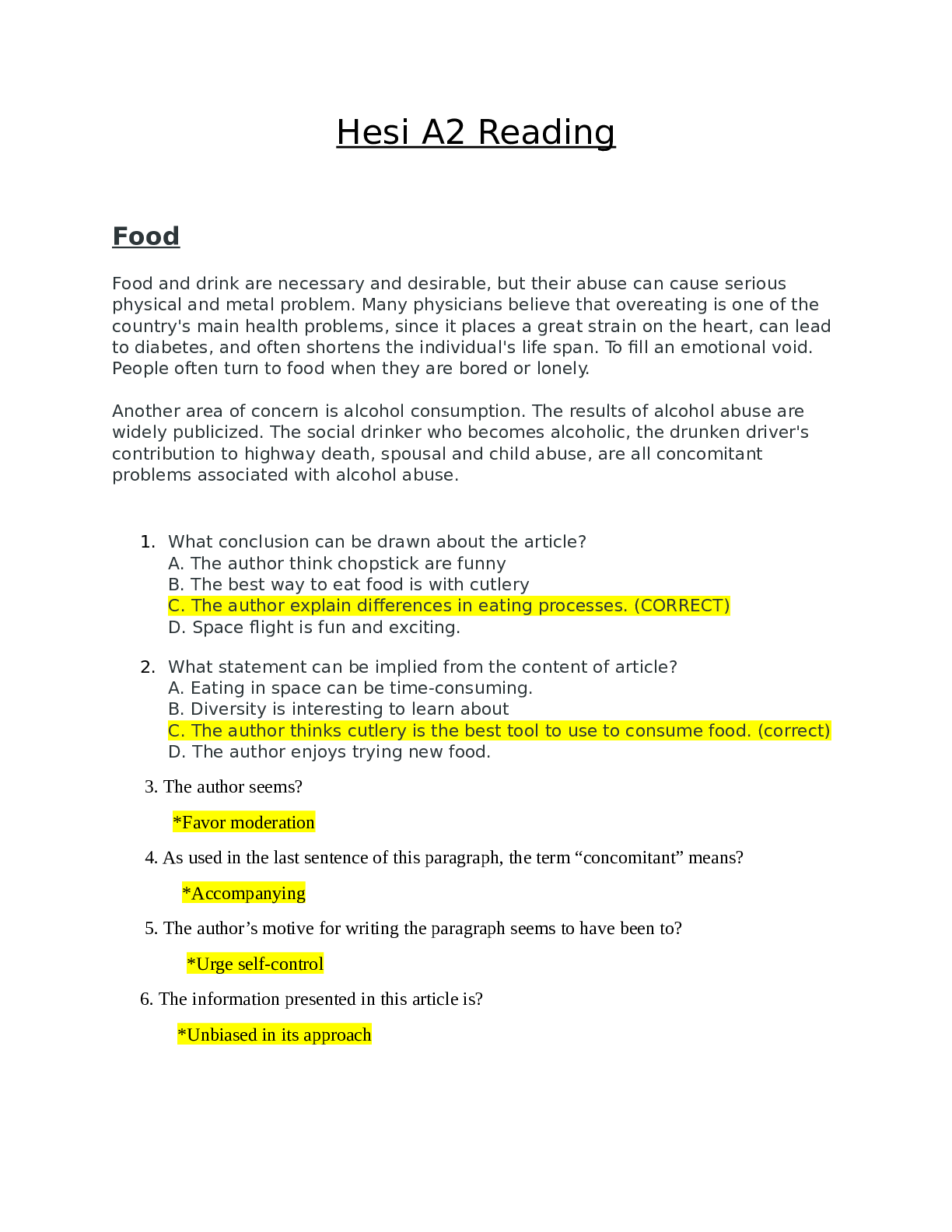


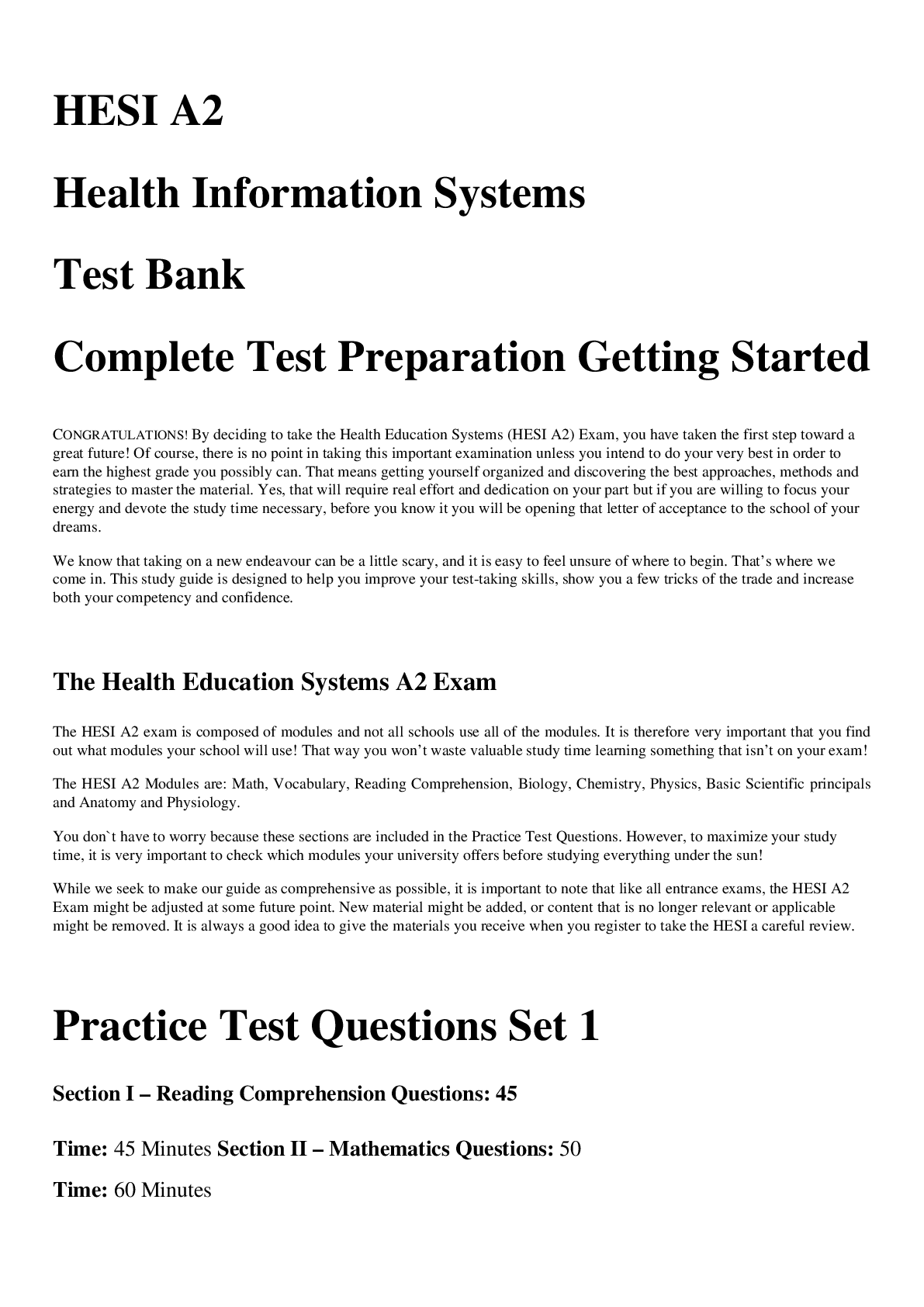

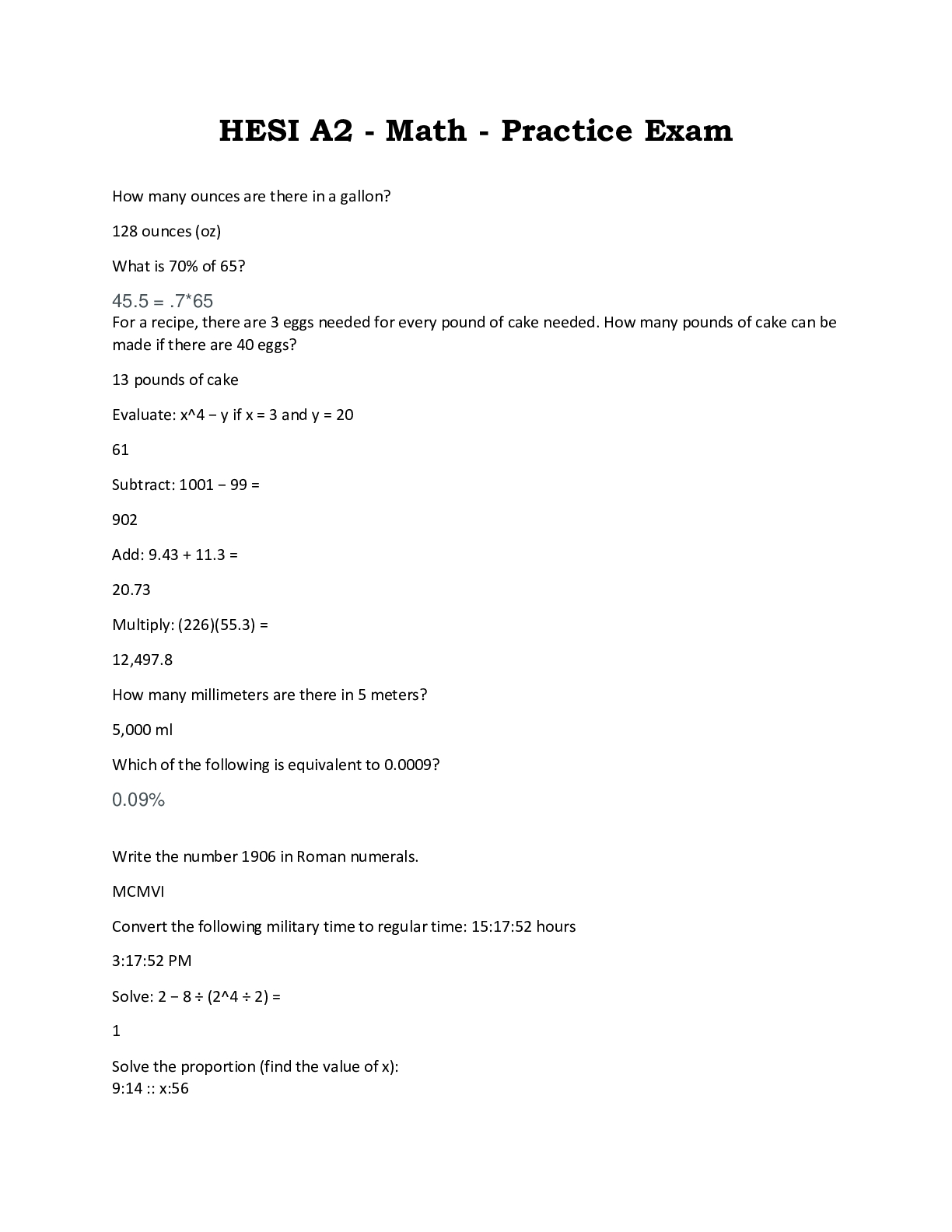
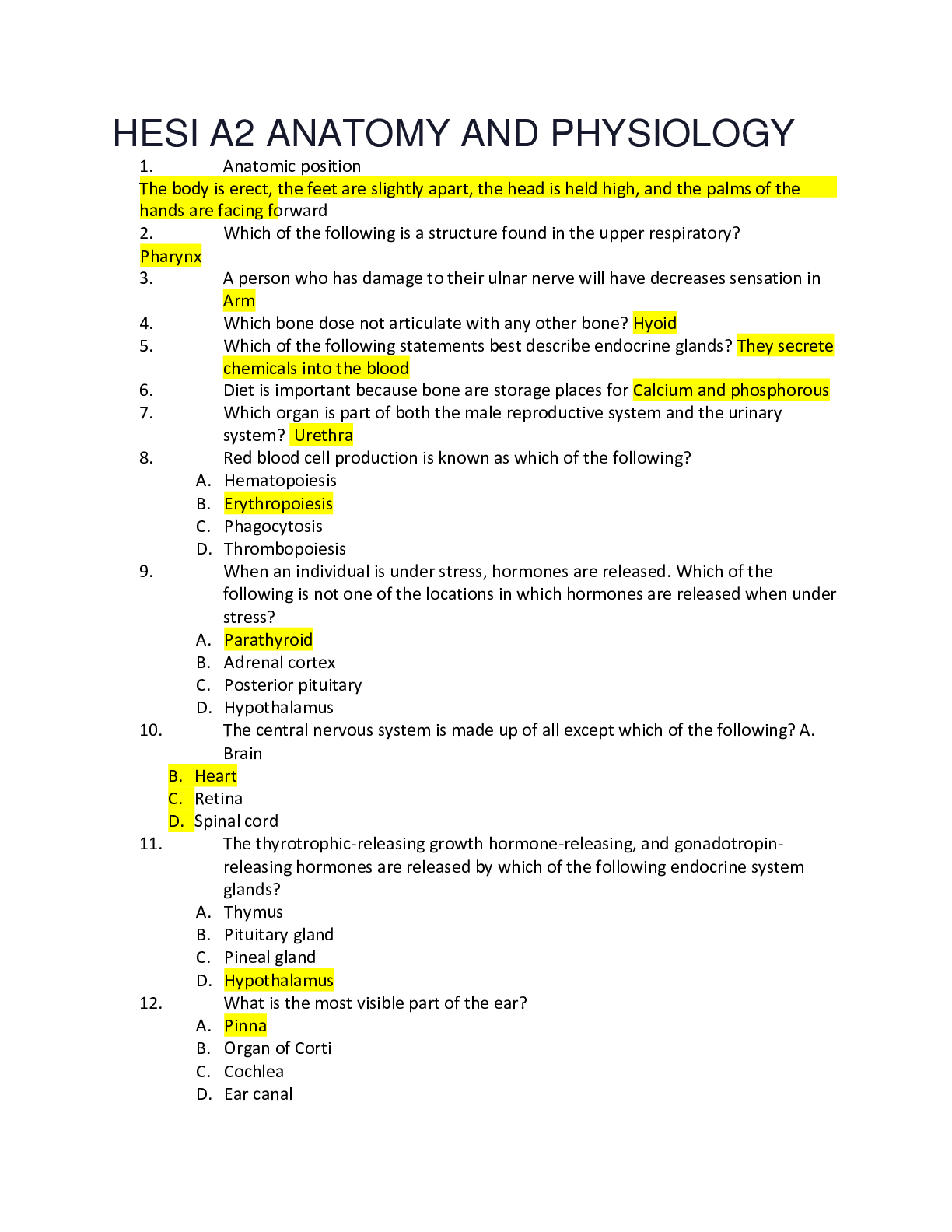

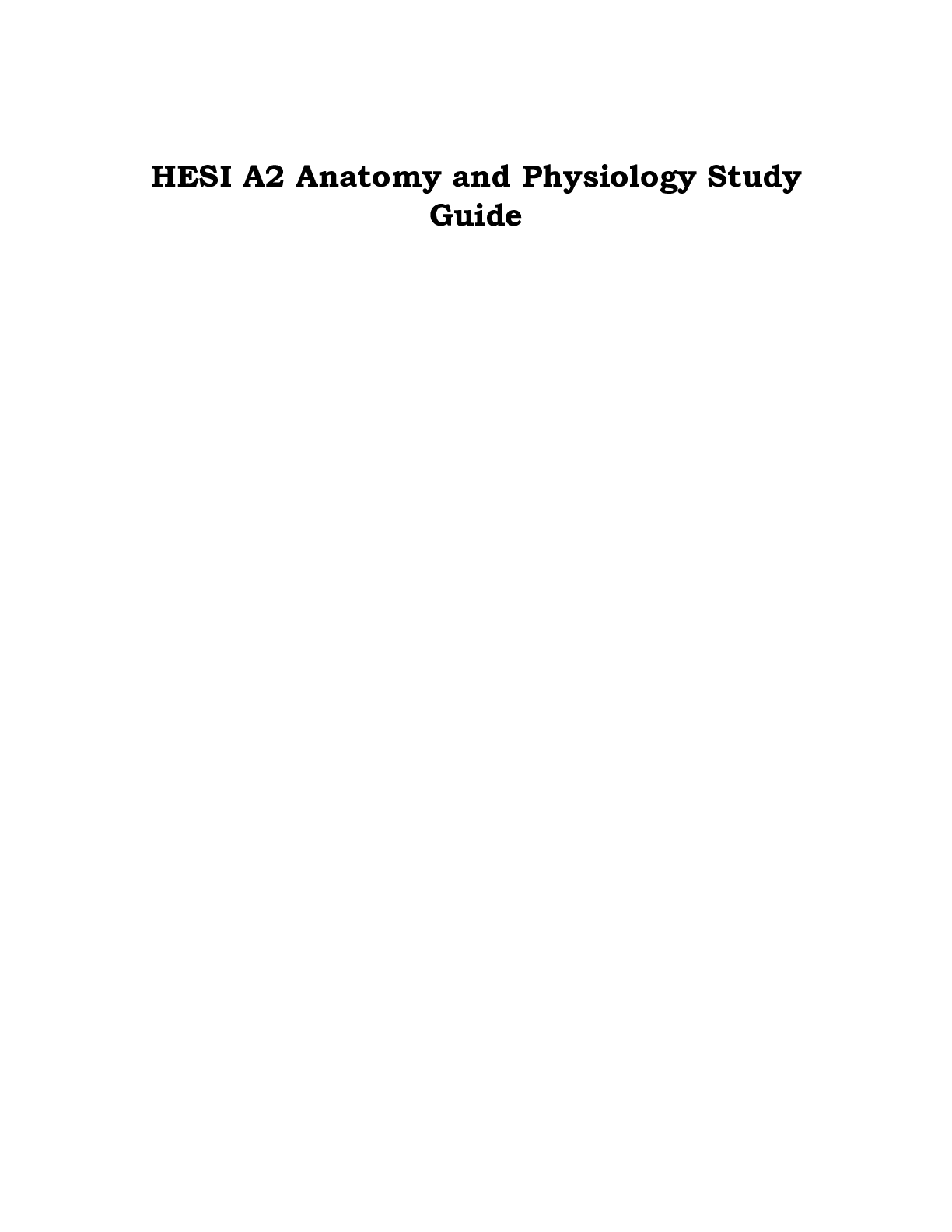
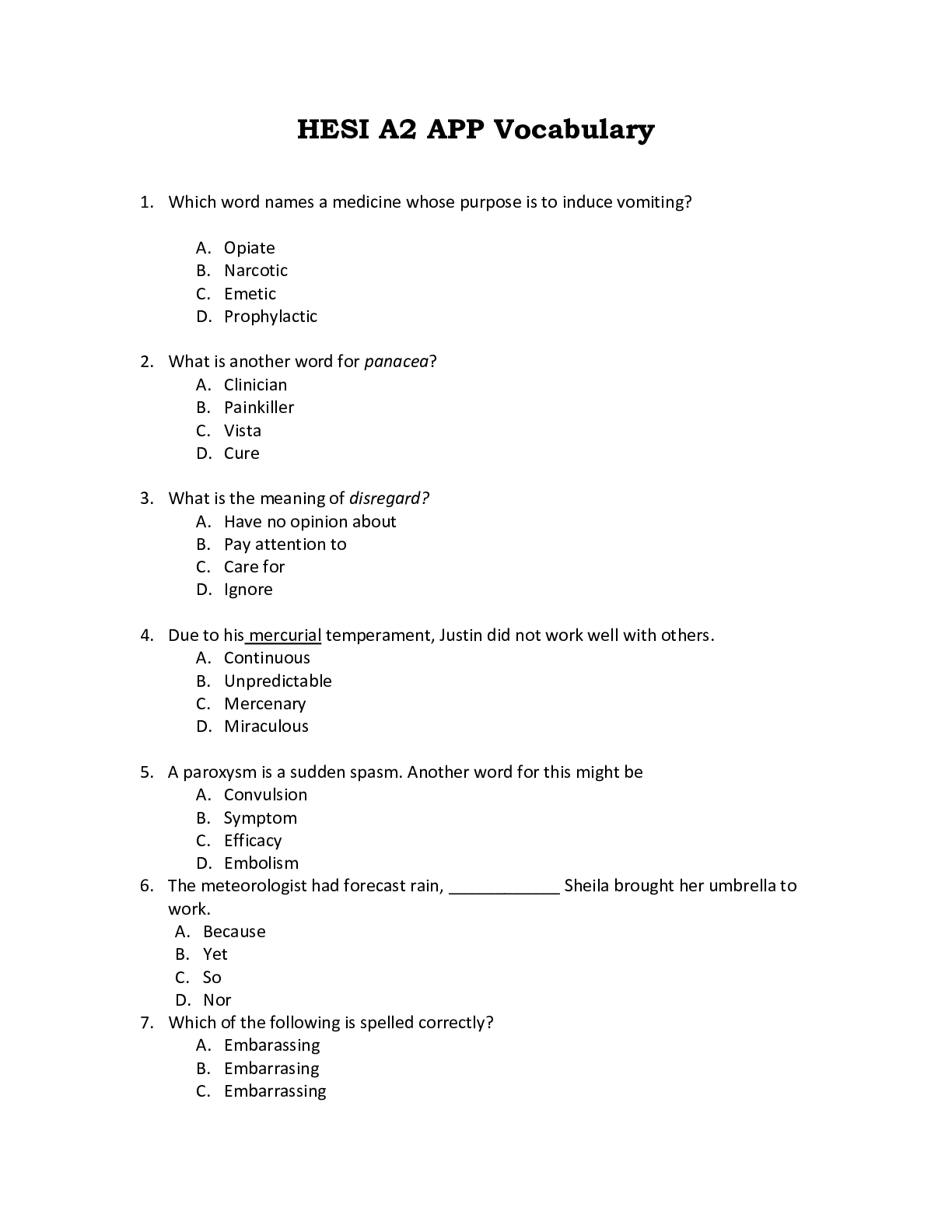
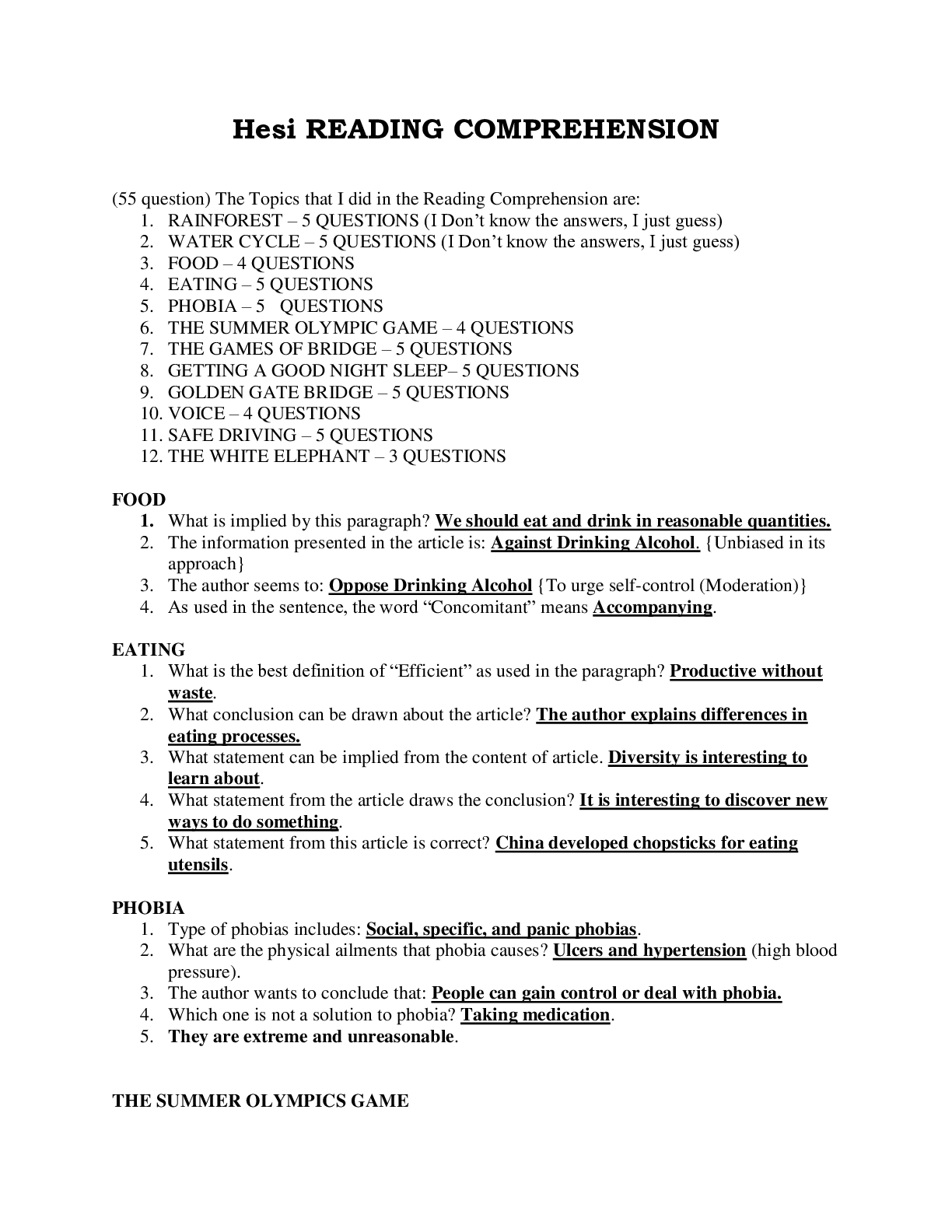






 (1).png)



